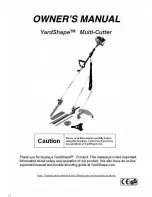
Calibration— Type 323
n
□
□
□
□
□
□
□
□
□
□
39. Adjust External Horizontal Variable
Page 6-23
Balance (R218)
No trace shift as EXT HORIZ VAR control is ro
tated throughout its range.
40. Check External Horizontal Deflection
Page 6-23
Factor
200 to 300 millivolts/division.
41. Check External Horizontal Deflection
Page 6-24
Factor with 10X Attenuation
Two to three volts/division.
42. Check External Horizontal Var-
Page 6-24
iable Control Range
10:1 range or greater.
43. Check External Horizontal Coupling
Page 6-24
Correct signal coupling in the EXT TRIG OR HORIZ
positions of the Trig/Horiz Coupling switch.
44. Check External Horizontal Bandwidth
Page 6-24
Not more than —3 dB at 10 kilohertz.
45. Check External Blanking
Page 6-24
Five-volt positive peak signal blanks trace.
46. Check Internal Triggering Operation
Page 6-25
Stable display in INT TRIG AC and ACLF REJ
positions of the Trig/Horiz Coupling switch with the
TRIGGER control set to -+- AUTO, variable positive-
slope area, variable negative-slope area and
AUTO; check with 0.3-division display at 400
kilohertz and a 0.75-division display at four mega
hertz.
47. Check External Triggering Operation
Page 6-26
Stable display in EXT TRIG OR HORIZ AC and DC
positions of the Trig/Horiz Coupling switch with the
TRIGGER control set to + AUTO, variable positive-
slope area, variable negative-slope area and —
AUTO; check with a 75-millivolt signal at 400
kilohertz and a 190-millivolt signal at four mega
hertz.
48. Check Low-Frequency Triggering
Page 6-26
Operation
External, stable display in EXT TRIG OR HORIZ
AC and DC positions of the Trig/Horiz Coupling
switch with the TRIGGER control set to - f AUTO,
variable positive-slope area, negative-slope area
and — AUTO; check with 75-millivolt signal at 30
hertz. Internal, stable display in INT TRIG OR
HORIZ AC positions of the Trig/Horiz Coupling
switch with the TRIGGER control set to - f AUTO,
variable positive-slope area, variable negative-slope
area and — AUTO; check with a 0.3-division dis
play at 30 hertz.
49. Check Low-Frequency Reject
Page 6-27
Operation
Stable display with 0.3-division display at 30 kilo
hertz with the TRIGGER control set to -f- and —
AUTO and in the variable positive- and negative-
slope areas; stable display cannot be obtained
at 30 hertz.
50. Check Trigger Slope Operation
Page 6-27
Stable triggering on correct slope of trigger sig
nal in the
AUTO, variable positive-slope area,
variable negative-slope area and — AUTO posi
tions of the TRIGGER control.
F I 51. Check TRIGGER Control Range
Page 6-27
EXT TRIG OR HORIZ ATTEN switch set to I X , at
least + and - 0 .8 volts,- EXT TRIG OR HORIZ
ATTEN switch set to 1 0 X , at least -f- and — 8
volts.
0 52. Check Calibrator Risetime
Two microseconds or less.
1 | 53. Check Calibrator Repetition Rate
n 54. Check Calibrator Duty Cycle
40% to 60%.
CALIBRATION PROCEDURE
General
The following procedure is arranged in a sequence which
allows the Type 323 to be calibrated with the least inter
action of adjustments and reconnection of equipment The
steps in which adjustments are made are identified by the
symbol O following the title. Whenever possible, instrument
performance is checked in the "CHECK" part of the step be
fore an adjustment is made. The "ADJUST" part of the
step identifies the point where the actual adjustment is
made. Steps listed in the "INTERACTION" part of the step
may be affected by the adjustment just performed. This is
particularly helpful when only a partial calibration procedure
is performed.
NOTE
To prevent recalibration o f other parts of the in
strument when perform ing a p artial calibration,
readjust only if the tolerances given in the CHECK
part o f the step are not met. However, when per
form ing a complete calibration, best overall per
formance is obtained if each adjustment is made
to the exact setting even if the CHECK is w ithin
the a llo w a b le tolerance.
In the following procedure, a test-equipment setup picture
is shown for each major group of checks and adjustments.
Beneath this setup picture is a complete list of front-panel
control settings for the Type 323. To aid in locating individ
ual controls which have been changed for the new setup,
these control names are printed in bold type. Each step con
tinues from the equipment setup and control settings used
in the preceding step(s) unless noted otherwise. If only a
partial calibration is performed, start with the test equip
ment setup preceding the desired portion. External controls
or adjustments of the Type 323 referred to in this procedure
are capitalized (e.g., VOLTS/DIV). Infernal adjustment names
are initial capitalized only (e.g., Limit Centering).
6-4
©
Содержание 323
Страница 4: ...Type 323 Fig 1 1 Type 323 Oscilloscope ...
Страница 14: ...Operating Instructions Type 323 2 2 Fig 2 1 External controls connectors and indicators ...
Страница 39: ...Circuit Description Type 323 3 4 Fig 3 3 Paraphase Am plifier simplified ...
Страница 51: ...Circuit Description Type 323 3 16 Fig 3 8 Blocking Oscillator simplified ...
Страница 71: ...Maintenance Type 323 4 15 Fig 4 13 Transistor data ...
Страница 72: ...Maintenance Type 323 4 16 Fig 4 14 M ain circuit board p a rtia l loft side vertical circuit components ...
Страница 147: ...T Y P E 3 2 3 O S C I L L O S C O P E B L O C K D IA G R A M MRI4 i ...
Страница 157: ...BL OCK DIAGRAM ...
Страница 158: ......
Страница 161: ...A TYPE 323 OSCILLOSCOPE ...
Страница 162: ...1 TYPE 323 OSCILLOSCOPE ...
Страница 163: ...FIG 2 CABINET ...
Страница 164: ...OPTIONAL ACCESSORIES 016 0119 00 1 POWER PACK 016 0112 00 1 COVER protective oscilloscope ...
















































